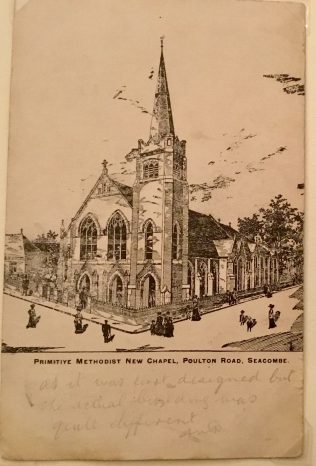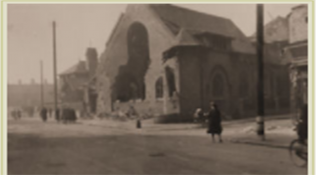Wallasey Seacombe Poulton Road Primitive Methodist Church
Poulton Road, Seacombe, Wallasey


In 1923, the PM Conference Handbook described Seacombe as, ‘a church with a future’. It continued, ‘The first church was erected in 1868 and the present school-church in 1907. It has a membership of over 300 and nearly 600 scholars and the main church building is being anticipated.’
The postcard opposite is fascinating, as it shows a church that was never built! It clearly shows the original architect’s design for the new building in 1907. Tantalisingly, someone has written ‘As it was first designed but the actual building is quite different’.
Chris Wells has researched the story:-
According to Kelly’s 1850 directory, page 671:
‘WALLASEY is a parish comprising the townships of Wallasey, Liscard and Poulton-cum-Seacombe.’
Then on page 674:
‘POULTON-CUM-SEACOMBE is a township, 1 mile south by east from Wallasey; in 1841 had 371 houses and 2,446 inhabitants. Population in 1801, 178; in 1831, 1212. SEACOMBE, the most populous part of the township, is situated on the banks of the Mersey, opposite Liverpool, and commands a striking view of that port and the shipping. The hotels and taverns afford every accommodation to the multitude of visitors brought over here by the steamers.’
I have not been able to find a definitive history of Primitive Methodism in this area; what follows has been pieced together from various sources. A description of all of the societies and PM chapels in Seacombe is given in the download below.
A shortened version of the story of the first Poulton/Seacombe Primitive Methodist society (formed in 1837) and the second society (formed in 1865) and its Brighton Street chapel (opened in 1868) can be found here.
The First Poulton Road Chapel and School 1907 to 1928
Early 1900s: The History of Wallasey states that early in the 20th century, the Prims leased buildings in Brighton Street from the Salvation Army for a Primitive Methodist chapel and school. This is confirmed by a 1908/9 25” map which shows the Brighton Street/Shaw Street building labelled ‘S.A. Hall’. I wonder whether, in about 1900, the society decided to build a new and larger chapel (in Poulton Road); they sold their Brighton Street chapel to the Salvation Army to raise early funds but then leased the premises back until the new chapel was opened.
1907: A 1923 booklet states ‘Seacombe is a church with a future. The first church was erected in 1868 (the one in Brighton Street) and the ‘school-church’ was erected in 1907 in Poulton Road Seacombe at the junction with Northbrook Road.’
1908/9: A 1908/9 25” map shows the new chapel’s somewhat irregular outline, labelled ‘Prim. Meth. Church’. The footprint scales about 60ft x 56ft. The 1923 booklet continues, ‘[the society] has a membership of over 300 and nearly 600 scholars and the main church building is being anticipated [this presumably refers to plans for the 1927/8 church – see below].’
1935/6: The 195/6 25” Map shows that the chapel had been converted into a Sunday School and a new Chapel had been built on to it to the south, as will now be described.
The Second Poulton Road Chapel and School 1926 to 1941
About 1920: The History of Wallasey says: ‘After World War One it was decided to open a new chapel. A site was obtained in Poulton Road, Seacombe, on the corner of Northbrook Road [this seems to be wrong – the Prims already had that site with the first chapel on it].’
1927/8: The History of Wallasey continues: ‘The stone-laying ceremony [for a new chapel] was held on 21st May, 1927, and was laid by Charles Wass Esq, J.P., who was to become Vice President of the Primitive Methodist Church in 1930. The church opened for worship on 4th April, 1928 …
A 1935/6 25” map shows what had happened. The new chapel had been built onto the south side of the 1907 chapel which had itself been converted into a Sunday School. The new chapel scaled at about 60 ft square.
1940: The listing of Methodist Buildings gives the statistics of this chapel: built of brick, seating for 600 in pews, and having three school halls and eleven other rooms.
1941: In March the church was destroyed during an air-raid (see image).
1944: The church was demolished.





Comments about this page
Regarding the postcard, etc. :
There was also an intention for the following but was it built in 1906 or c.1907 or not.
The Builder, vol. 91, issue 3312, page 159, 28th July, 1906.
List of Competitions, Contracts, etc.
Seacombe. – METHODIST SUNDAY SCHOOL——–New Primitive Methodist Sunday School, Poulton-road, Seacombe, Quantities and all information on application to Mr. Hy. Harper, 54 Long-row, Nottingham.
………………………….
The Liverpool Daily Post of 19 February 1868 reported as follows:
‘LAYING THE FOUNDATION STONE OF A PRIMITIVE METHODIST CHAPEL IN SEACOMBE.
Yesterday afternoon, at half-past three o’clock, the ceremony of laying the foundation stone of a new chapel in connection with the Primitive Methodist Society took place, at Seacombe, in the presence of a considerable assembly. The Primitive Methodist Society at Seacombe forms part of a circuit, the head-quarters of which are in Birkenhead, and has been in existence about three years. It numbers 40 members, together with about 80 attendants at chapel. The circuit ministers are Revs. T. Hindley and J. Hill. The society at Seacombe has for some time past worshipped in a wooden structure; but having secured an eligible piece of land, at the corner of Brighton-street and Pitt-street, is now engaged in building thereon a permanent chapel, at a cost of £600, exclusive of the land. The plans have been designed by Mr Williams, of Seacombe, and embrace a chapel calculated to seat 400 persons, vestries, &c., and a Sunday School capable of accommodating 200 children. The building will be of brick with stone dressings. Mr. Geo. Dickinson, of Seacombe, is the contractor. The ceremony yesterday commenced with the singing of a hymn, after which the Rev. J. Hill read a portion of Scripture, and the Rev. T. Hindley engaged in prayer. The Rev. Mr. Ball, of Liverpool, then made an address, in which he enumerated the leading doctrines held and taught by the Primitive Methodists …’
Brighton Street still exists but I cannot find any reference to Pitt Street (it is not in the 1861 or 1871 Censuses). However, there was a Platt Street running off Brighton Street (one street south of Brougham Road) which seems to have been built between the 1861 and 1871 Censuses. An 1876 map shows an unlabelled double frontage building with rear extension on the south side of the junction (https://www.old-maps.co.uk/#/Map/332156/391233/12/100093). Could this have been the chapel? The main building scales at about 40 foot square which seems too small to seat 400. It appears on maps up to and including 1935, seems to have been split on a 1954 map and has disappeared by 1977.
Strangely, I have not been able to find a newspaper report of the chapel opening.
Further information about Primitive Methodism in Wallesey can be found at the History of Wallesey website.
In relation to this chapel it records that after “World War One it was decided to open a new chapel. A site was obtained in Poulton Road, Seacombe, on the corner of Northbrook Road. The stone laying ceremony was held on 21st May, 1927, and was laid by Charles Wass Esq, J.P., who was to become Vice President of Primitive Methodist Church in 1930. The church opened for worship on 4th April, 1928, with the dedication service started by Revd. J.H Saxton of Middlesborough.
In the Second World War the Primitive Methodist Church was destroyed by a bomb during the March 1941 air-raids. The church was then demolished in 1944.”
The 1941 statistical return records the chapel as brick built seating 600 with three school halls and 11 other rooms.
Add a comment about this page